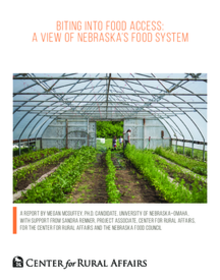Why study the food system?
In Nebraska, more than $4.4 billion is spent annually on food and 90 percent of that comes from outside of the state. Nebraska’s food system is reliant on other areas of the country, the strength of their food systems and local economies, and the availability of their natural resources to feed its population.
By addressing key issues in food, farm, small business, and community-level and institutional policy, there is potential to identify strengths, changes needed, and gaps in the food system. Good food policy and effective coordination between food system stakeholders will produce strong farms, open new or existing markets that are difficult to access, cultivate a resilient food economy, and preserve a healthy future for all Nebraskans.
This community food assessment is part of a larger project titled, “Food Policy Opportunities for Nebraska: Growing Healthy Food Systems.” It is designed to provide the background research that defines the current food system landscape of the state, presenting baseline information to the newly formed Nebraska Food Council. This council follows the model of food councils and coalitions across the country to bring a diverse array of actors involved in various parts of the food system together to create positive change.
What is the Nebraska Food Council?
The project officially began on Aug. 18, 2015, with a public event to explore the potential for food councils in Nebraska. The evening included a keynote presentation from Mark Winne, nationally renowned food policy council expert, and a panel discussion with food system stakeholders. Following this public meeting, a smaller group of key stakeholders representing diverse sectors of our food system and communities statewide began working toward creating Nebraska state and local food councils. This work has the potential to change our food system in ways that make it work better for all of us.
Vision and mission
The Nebraska Food Council envisions a thriving, inclusive, and accessible local food system that strengthens our economy and environment while fostering food security for all Nebraskans through collaboration with diverse agencies, organizations, individuals, and communities in the state.
Nebraska Food Council’s mission:
- Gather information from across the state to create a rich picture of Nebraska’s food systems through a statewide food assessment.
- Identify key food and agriculture policy issues and opportunities.
- Educate and advise policymakers and consumers.
- Organize support for change and new initiatives.
- Coordinate networks and connect partners.
- Build capacity for membership within communities by serving as a resource to provide opportunities for education and professional development.
Scope and structure of the report
The food system is a large and complex structure that contains many smaller, overlapping systems. A lot of discussion has been held about how best to define “local” in “local food.” Similarly, as communities begin to think about their local foodsheds, or the physical geography required to feed a given population, the boundaries and definitions of those foodsheds may vary and overlap. This report looks at the state of Nebraska as a whole, rather than creating a particular mile radius or sorting through various overlapping foodsheds of this region. The majority of this report focuses on state- and national-level data, with occasional attention to the county level when data is available and appropriate. Data collection reflects the values and priorities of dominant trends, which are currently focused around a globalized food system. Potential areas for future localized data collection are identified where appropriate.
This report follows the overall structure of the food system model to provide a snapshot or base-line data about each major component of the Nebraska food system. It begins with a snapshot of community demographics and characteristics of the state’s population. The report continues with a discussion of food production, including natural resources and farming trends in the state. Discussion ensues on food consumption and access, consumption trends and related health conditions, where and how citizens purchase or obtain their food, and what food security issues are seen across the state. The final research section covers food waste. The conclusion contains next steps from the Nebraska Food Council’s perspective, including an agenda for future research and initial policy priorities.
Engagement opportunities have been highlighted throughout this report to identify opportunities for readers to engage with the food system or provide input to local, regional, or state policy by participating.


